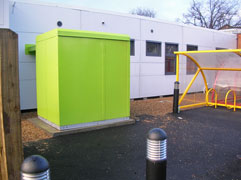Integrating Renewable Technologies for Energy Efficiency
Interseasonal Heat Transfer is a complementary fusion of the two front runners in on-site renewable energy: Solar Thermal and Ground Source Heat Pumps.
The first priority in achieving energy efficiency in buildings is to use good design so that the overall energy requirement is reduced. This will include a well-sealed building envelope to limit heat losses in winter. The second priority is to ensure that the design is well built and the third must be to ensure that it is well maintained and well managed.
Having reduced energy requirements by good design, the focus turns toward alternative renewable technologies that limit fossil fuel-based heating and power.
Renewable Energy Systems
There are strengths and weaknesses for each of the main renewable technologies, which are summarised at Renewable Energy Options.
As it seems that most of these options are not fully satisfactory on their own, we need to look at integrating the merits of different technologies so that the weaknesses of one can balance the strengths of others.
Let’s start with solar thermal heat collection in summer: this is a well developed technology which can heat water efficiently and provide gallons of hot water in summer. If you are running a laundry that is great news. Otherwise you may not be able to use gallons of hot water in summer. Hot water can also be provided in spring and autumn if you increase your investment in solar panels – which will yield an even greater surplus of hot water in the summer holidays. The very urgent need is for a thermal heat store to retain this summer heat until you need it for space heating in winter.
Ground Source Energy
Let’s look at ground source energy. The key merit of a heat pump is that it can achieve a Coefficient of Performance (CoP) of 4 – in standard conditions. A heat pump starting with an autumn ground temperature of 10°C, and delivering 40°C to an efficient underfloor heating system, can indeed achieve a CoP of 4 on this 30°C uplift.
However, there are limitations, which come from the simple fact that heat only moves very slowly in the ground. When the heat pump sucks heat from the ground (using a slinky pipe or a borehole) then the ground gets colder and the heat pump must pump harder to achieve the 40°C required. The CoP will fall from 4 to a lower level. It may fall to only 2 – when the heat pump ceases to be economic to run (or to save CO2).
Renewable Technology Integration
The answer to these conundrums is provided by the renewable technology integration from ICAX which has invented, developed and patented ThermalBanks™ to store excess summer heat, from the time it is freely available, until the time that it is needed for space heating in winter. Heat is stored in ThermalBanks – with no complex losses on conversion that limit the value of photovoltaic cells, where only 10% of the incoming sunlight is typically converted into electricity.
The ThermalBank invention is at the heart of Interseasonal Heat Transfer from ICAX. ICAX stores summer heat in large ThermalBanks in the ground and raises the temperature from 10°C up to over 25°C.
An ICAX heat pump, instead of starting from 10°C, starts from 25°C. An uplift of only 15°C is needed to achieve the 40°C required for underfloor heating. Half as much work – double the CoP. The CoP of an ICAX heat pump starts at 8 in the autumn, instead of 4.
So these big advantages are available from integrating renewable technologies.
Integration of Heating and Cooling
But integration does not stop there. There are huge benefits from further integration. Most well designed modern buildings, which retain heat in winter, also retain heat in summer and therefore require cooling. Air conditioning, the standard solution, is very expensive to install and very expensive to run. It is based on the principle of “wasting” heat to the (hot) outside air. For those who have invested in IHT for heating, the good news is that the same equipment (with minor modifications) can also provide cooling in summer. It can also provide cooling at a much lower running cost, by heat exchanging with cold ground, instead of hot air.
ICAX has recently developed an extension to Interseasonal Heat Transfer called Intrabuilding Heat Transfer™. This improves energy efficiency where there is a simultaneous need for heating and cooling within a building. Frequently a fileserver room, or one with high occupancy or solar heat gains may need cooling at the same time as a north facing low occupancy room in the same building needs heating. The control mechanism on the ICAX Skid mounted plant is able to extract heat from hot areas and transfer it to cold areas in conjunction with Mitsubishi’s WR2 technology and two pipe fan coil condenser units: joined-up heating. This opens up further energy savings and is another step towards achieving Zero Carbon buildings.
Joined-up Heating
There are great merits in integrating heating and cooling – especially if both are based on carefully matched integrated renewable technologies. ICAX can bring together sustainable technologies to provide joined-up heating.
See also: Independent report on IHT by Transport Research Laboratories
See also: Clean energy sources
See also: Renewable Heat Incentive
See also: Smart Grids

